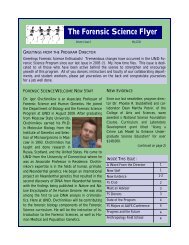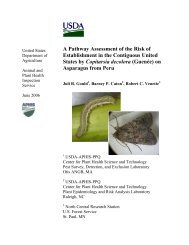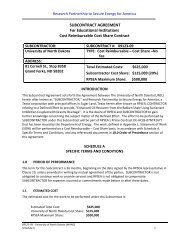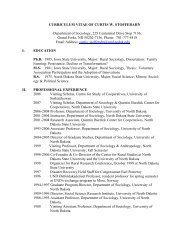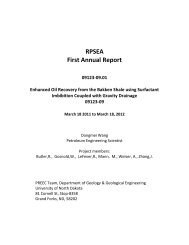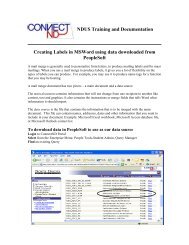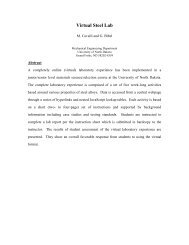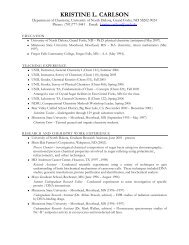Dirigent proteins in conifer defense: gene discovery, phylogeny, and ...
Dirigent proteins in conifer defense: gene discovery, phylogeny, and ...
Dirigent proteins in conifer defense: gene discovery, phylogeny, and ...
You also want an ePaper? Increase the reach of your titles
YUMPU automatically turns print PDFs into web optimized ePapers that Google loves.
34<br />
Table 4. Relative abundance of select DIR <strong>and</strong> DIR-like <strong>gene</strong>s <strong>in</strong> response to weevil herbivory or mechanical wound<strong>in</strong>g <strong>in</strong> spruce xylem <strong>and</strong> bark. a<br />
Bark Xylem<br />
Mechanical<br />
at 48 h<br />
Mechanical<br />
at 6 h<br />
Mechanical<br />
at 2 h<br />
Weevil<br />
at 48 h<br />
Weevil<br />
at 6 h<br />
Weevil<br />
at 2 h<br />
Mechanical<br />
at 48 h<br />
Mechanical<br />
at 6 h<br />
Mechanical<br />
at 2 h<br />
Weevil<br />
at 48 h<br />
Weevil<br />
at 6 h<br />
Weevil<br />
at 2 h<br />
DIR<br />
Name<br />
PDIR2 1.28 1.44 46.92 0.99 10.49 53.36 1.19 1.06 14.08 0.56 0.93 4.59<br />
PDIR5 0.64 0.34 3.70 2.19 2.47 14.45 0.19 0.51 43.32 0.30 21.71 29.31<br />
PDIR6 2.24 0.60 9.14 4.77 3.58 21.82 0.90 7.92 39.76 10.34 54.13 27.25<br />
PDIR8 2.87 5.22 28.19 20.90 92.24 51.84 0.61 19.66 77.13 22.46 511.06 38.15<br />
PDIR13 5.48 2.48 27.15 3.37 90.39 115.66 1.07 3.25 20.47 4.06 71.67 25.86<br />
PDIR1 1.66 0.86 0.06 0.56 0.31 0.71 1.22 0.58 0.52 0.42 0.36 1.46<br />
PDIR10 1.98 0.85 0.13 4.22 1.06 1.03 1.77 0.78 0.80 1.69 0.87 1.44<br />
PDIR12 2.34 2.10 0.60 12.07 5.66 2.90 1.16 0.61 2.98 2.82 1.77 3.53<br />
a Values were determ<strong>in</strong>ed us<strong>in</strong>g real-time PCR <strong>and</strong> represent fold-change differences relative to transcript expression <strong>in</strong> untreated control tissues from the same time po<strong>in</strong>t (see<br />
Figure 3).<br />
tional experiments have also shown that transcript<br />
levels for PDIR2, PDIR5, PDIR6, PDIR8 <strong>and</strong><br />
PDIR13 rema<strong>in</strong> elevated <strong>in</strong> bark tissue until at<br />
least 72 h after mechanical wound<strong>in</strong>g when comb<strong>in</strong>ed<br />
with a one-time application of the plant<br />
hormone methyl jasmonate (0.01% MeJA dissolved<br />
<strong>in</strong> 0.1% Tween; unpublished data).<br />
Similar to these observations <strong>in</strong> bark tissue, all<br />
five Sitka spruce DIR-a <strong>gene</strong>s were also <strong>in</strong>duced <strong>in</strong><br />
xylem tissue harvested from the same trees (Figure<br />
3 <strong>and</strong> Table 4). Xylem tissue was not profiled<br />
by cDNA microarray due to limit<strong>in</strong>g tissue quantities.<br />
The response of DIR-a <strong>gene</strong>s was <strong>gene</strong>rally<br />
more rapid after mechanical wound<strong>in</strong>g than weevil<br />
feed<strong>in</strong>g <strong>in</strong> xylem, <strong>and</strong> was of similar magnitude to<br />
that observed <strong>in</strong> bark tissue with maximum<br />
responses to each treatment as follows: PDIR2 –<br />
14.0-fold, weevil 48 h; 4.5-fold, mechanical 48 h;<br />
PDIR5 – 43.3-fold, weevil 48 h; 29.3-fold, mechanical<br />
48 h; PDIR6 – 39.7-fold, weevil 48 h; 54.1-<br />
fold, mechanical 6 h; PDIR8 – 77.6-fold, weevil<br />
48 h; 511.0-fold, mechanical 6 h; <strong>and</strong> PDIR13 –<br />
20.4-fold, weevil 48 h; 71.6-fold, mechanical 6 h.<br />
In contrast to the <strong>in</strong>duction by mechanical<br />
wound<strong>in</strong>g or <strong>in</strong>sect-attack of transcript accumulation<br />
of Sitka spruce DIR-a <strong>gene</strong> subfamily members,<br />
the DIR-b subfamily members PDIR1 <strong>and</strong><br />
PDIR10 did not show <strong>in</strong>creased transcript levels <strong>in</strong><br />
response to weevil feed<strong>in</strong>g or mechanical wound<strong>in</strong>g<br />
<strong>in</strong> either bark or xylem tissues (Figure 3 <strong>and</strong><br />
Table 4). Both <strong>gene</strong>s demonstrated reduced transcript<br />
levels <strong>in</strong> bark tissue 48 h after <strong>in</strong>itiation of<br />
weevil feed<strong>in</strong>g (PDIR1 – 16.6-fold reduced;<br />
PDIR10 – 7.6-fold reduced), similar to results<br />
obta<strong>in</strong>ed with microarrays (Table 1). PDIR12,<br />
also from the DIR-b subfamily, was <strong>in</strong>duced <strong>in</strong><br />
response to mechanical wound<strong>in</strong>g <strong>and</strong> to a lesser<br />
extent by weevil feed<strong>in</strong>g, <strong>in</strong> both bark <strong>and</strong> xylem<br />
tissues. Peak <strong>in</strong>duction to mechanical wound<strong>in</strong>g<br />
was observed <strong>in</strong> bark tissue 2 h post treatment<br />
(12.0-fold), compared to a maximum of 2.9-fold <strong>in</strong><br />
xylem after 48 h of weevil feed<strong>in</strong>g.<br />
Constitutive expression of selected spruce DIR<br />
<strong>and</strong> DIR-like <strong>gene</strong>s<br />
In an attempt to illustrate differences <strong>in</strong> spatial<br />
patterns of RNA expression, the relative constitutive<br />
abundance of six DIR-a <strong>and</strong> three DIR-like<br />
<strong>gene</strong>s was quantified <strong>in</strong> total RNA isolated from<br />
different stem tissues (cortex, phloem, cambium,





